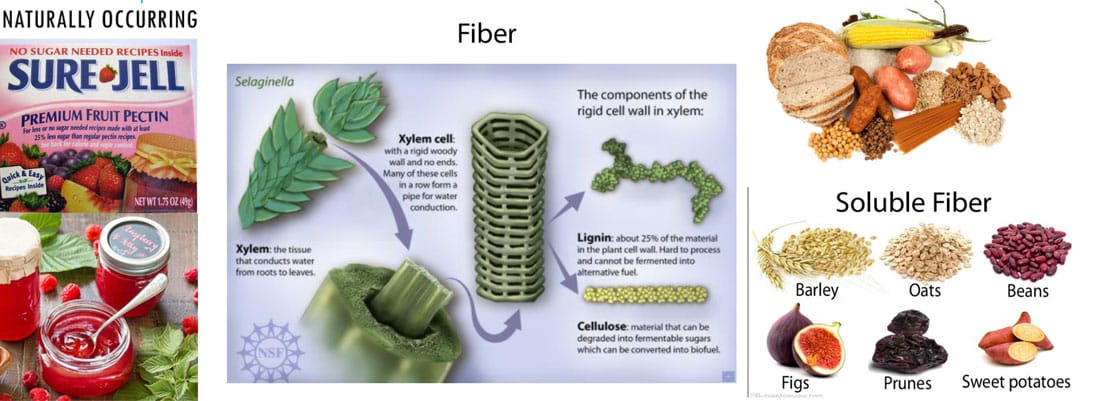Written by APD. Holly Baxter
October 2017
What is dietary fiber?
Dietary fiber, or fiber, is sometimes referred to as “roughage.” It is a type of carbohydrate found in plant foods and is made up of a number of sugar molecules linked together by a specific type of bond. But unlike other carbohydrates (such as starch), dietary fiber is bound together in such a way that it cannot be readily digested in the small intestine. Humans lack the enzymes necessary to break this down. However, some types of fiber can be digested and fermented by bacteria in the gut.
What types of dietary fiber are in our foods?
There are 2 types of fiber, which can be defined as polysaccharides and non-starch polysaccharides.
Polysaccharides are large, long chains of single sugar molecules known as monosaccharide units. These are bound together by glycosidic linkages. These include cellulose, hemicellulose, pectins, gums and mucilages. Cellulose is the main constituent of plant cell walls found in vegetables fruits and legumes. Hemicelloses is the main fiber found in cereals while pectins are typically found in fruits and vegetables, and are also used as stabilizers and a number of manufactured foods. Mucilage’s or gums are also commonly used as food stabilizers and additives in manufactured food products.
Non-starch polysaccharides include lignins which are the tough woody part of plant based foods. An example of non-starch polysaccharides are the stringy fibrous part you see in celery or an under ripe banana, as well as the skin of many fruits.
Dietary fiber can be categories as being either soluble or insoluble fiber. Most plant foods contain a small amount of each and it is important to include a variety of both as part of your diet.
What is soluble fiber?
Soluble fiber dissolves in water to form a thick gel-like substance in the stomach. Soluble fiber is easily broken down by bacteria in the large intestine and provides us with a very small amount of calories (2 calories per gram). Primarily, soluble fiber is known for its role in heart health due to its ability to help lower LDL cholesterol, triglycerides, and total cholesterol. It is important to understand that these heart health benefits don’t exist independently. For example, if you have poor dietary habits or your diet is excessive in calories, simply by consuming more fiber on its own will not have the same cardiovascular health benefits. These findings correlate with a diet that is controlled for calories and incorporates modest amounts protein, carbohydrates and fats.
How does soluble fiber work?
Soluble fiber slows down the digestive process by delaying gastric emptying. As a result, it helps us to feel fuller for longer which is why fiber is known for its positive role in weight management. This is also the reason why fiber has a role in nutritional management of type 2 diabetes, as it is able to slow the rate at which carbohydrates are absorbed into the bloodstream. This can help regulate blood glucose levels, by preventing rapid rises in blood sugar following a carbohydrate containing meal.
Soluble fiber also increases the excretion or removal of bile acids. Fiber binds to bile acids in the small intestine, helping to eliminate cholesterol and other waste products from the body as well as decreasing liver production of cholesterol.
Oligosaccharides
These are long chain carbohydrate molecules that pass through the digestive track which are able to be fermented by the microflora present naturally in our large intestine into short chain fatty acids (SCFA) and other gases. These re-enter the circulatory system and inhibit cholesterol production at the liver.
What is insoluble fiber?
Insoluble fiber does not dissolve in water and passes through the gastrointestinal tract relatively intact and, therefore, is not typically a source of calories. These have a role in our digestive health and help with bowel health through its ability to alleviate constipation, reduce risk of hemorrhoids, other diseases of the gastrointestinal tract.
This type of dietary fiber also helps reduce the risk of developing type 2 diabetes and decreases the likeliness of someone who is pre-diabetic from progressing to Type 2 Diabetes. This is due to its role in blood sugar regulation. As previously mentioned, insoluble fiber is also able to slow down the absorption rate of carbohydrates, and results in a marked decrease in blood sugar levels and the demand for insulin.
How does Insoluble fiber work?
The primary role of insoluble fiber is to regulate gut motility by increasing the bulk of the stool. It also helps to speeds up the movement of food and waste through the digestive system, which can help prevent constipation. This type of fiber plays a role in promoting feelings of fullness and is also recognized as beneficial for long term weight managements. Insoluble fiber also plays a role in lowering inflammation, blood pressure.
Where can fiber be found?
Soluble fiber is found in a variety of foods, including:
- Beans and peas
- Fruits apples inside)
- Oats (such as oat bran and oatmeal)
- Nuts and seeds
- Vegetables
Insoluble fiber is found in a variety of foods, including:
- Fruits (especially the skins)
- Nuts and seeds
- Vegetables (especially the skins)
- Whole wheat flour
- Wheat bran
- Whole grain foods (such as brown rice and whole grain breads, cereals, and pasta)
How is your hunger level throughout the day?
You may have heard that breakfast is the most important meal of the day, but when you eat breakfast, you end up feeling hungrier later in the day. This is likely due to the type of carbohydrate you are consuming. If your breakfast contains highly refined, low fiber or low protein foods, then you will undoubtedly be left feeling hungry.
For example, white bread with jam and rice bubbles with milk will pass through the digestive system relatively quickly and of course leave you feeling hungry. To help minimize feeling hungry, try to find a cereal with 3g or more fiber per serve and include a protein source with it.
The same can be said for other meals and snacks throughout the day. A diet high in protein and dietary fiber will assist with helping you to feel fuller for longer.
How to increase your daily fiber intake?
1./ Look for whole grains on the ingredient list on a food package. Some examples of whole grain ingredients are: barley, brown rice, buckwheat, bulgur, millet, oatmeal, quinoa, rolled oats, whole grain corn, whole grain sorghum, whole oats, whole rye, and whole wheat.
Ingredients are listed in descending order by weight so the closer they are to the beginning of the list, the more of that ingredient is in the food.
2./ Switch from refined to whole grain versions of commonly consumed foods (such as breads, cereals, pasta, and rice).
3./ Limit consumption of products made with refined grains or flours such as cakes, chips, cookies, and crackers. Typically, these types of foods will also contain added sugars, saturated fat, and/or sodium and are common sources of excess calories.
4./ Start your day with a bowl of whole grain breakfast cereal such as bran or oatmeal that is high in dietary fiber and low in added sugars. Top your cereal with whole fruit (skin on) for sweetness and even more fiber! You can also add additional sweetness by using calorie free sugar substitutes.
5./ Keep raw, cut-up vegetables handy for quick snacks — choose colorful dark green, orange, and red vegetables, such as broccoli florets, carrots, and red peppers.
6./ Add beans and legumes to your diet such as garbanzo, kidney, or pinto beans. Add lentils to salads, soups, and side dishes (bolognaise or mince based dishes as they ca be easily disguised and take on the flavor of other ingredients being used, or if you enjoy the taste, serve them as a main dish.
7./ Try unsalted nuts and seeds in place of some meats and poultry.
If you have any questions or would like to enquire about nutrition coaching, please feel free to contact me by clicking on the contact links on my website.

Holly T. Baxter is an Australian Dietitian with over 13 years of experience in health and fitness. She holds a degree in Food Science and Nutrition and a Master of Dietetics from Deakin University. A former professional physique athlete, Holly has two World Championship titles. Her latest project, BiaBody, is dedicated to women’s health and fitness. As an APD Dietitian and Online Physique Coach, she focuses on evidence-based health education and empowering women through fitness.

